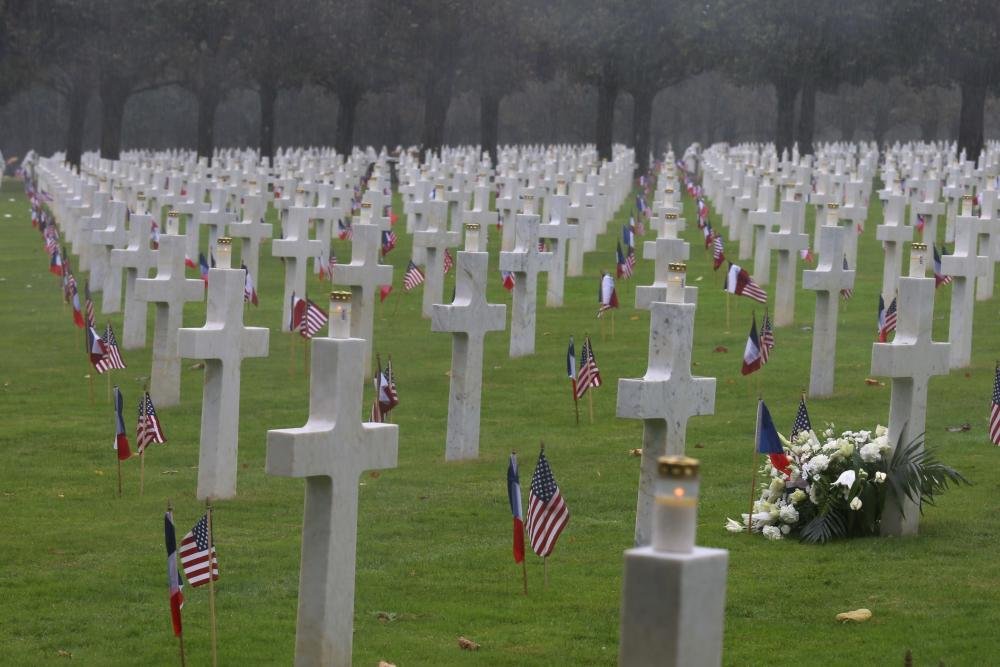The Great and Forgotten Battle
Soldiers of the American Expeditionary Force Advancing on the Meuse-Argonne Front
The Meuse–Argonne Offensive — The Great and Forgotten Battle
The Meuse–Argonne offensive contributed significantly to the end of World War One. The American army, known as the American Expeditionary Force (AEF), played a major role in the final allied offensive of the Great War (the so-called “Hundred Days” offensive), which encompassed most of the Western Front. The battle was fought over forty-seven days from September 18, 1918, until the final armistice which ended the war on November 11, 1918. The AEF primarily operated near the city of Verdun—the eastern region of the larger offensive—pushing northwest toward the important rail-head at Sedan in German occupied France.
The Meuse-Argonne offensive was both the largest and costliest battle in American history. A total of 1.2 million American soldiers were involved, with 26,777 confirmed dead. Most of the American dead were killed in the early phases of the battle, due to poor American tactics and inexperience in modern combat. But the AEF improved greatly as the battle unfolded. Some of the losses during the offensive can be attributed to to the Spanish flu epidemic then sweeping through the armies of both sides. There were over 350,000 casualties on both sides during the final offensive (primarily British, French, American, and German), of which Meuse-Argonne was major part.
By way of comparison, at the Battle of Gettysburg (the biggest battle on American soil) there were just under 200,000 soldiers present (on both sides), with killed in action (KIA) numbering under 8000 during the battle—more certainly died of wounds and sickness later. The Battle of the Bulge (which, at its peak) involved about 700,000 American soldiers, with just under 20,000 KIA. D-Day (June 6, 1944) involved about 400,000 American soldiers and sailors, with some 4400 confirmed dead. By all accounts, the Meuse-Argonne offensive dwarfs all American military engagements, before and after—yet few of us have heard of it, much less know anything about it.
The AEF was lead by General of the Armies, John J. Pershing, the single highest ranked commanding officer in American history. George Washington was given the same title with seniority in 1976 as part of the American bicentennial—but Pershing held it while in command. Pershing, who first fought in the Spanish-American War, was best known at the time for chasing down Pancho Villa in Mexico (1916). Once he was named General of the Armies and chosen to lead the AEF, Pershing refused to allow newly arriving American soldiers to be fed piecemeal into the the ranks of British and French armies as replacements for their depleted forces. Pershing would command the AEF independently, but operate in close co-ordination with the French and British armies, much to their dismay. Initially, Pershing utilized frontal assaults on well-defended German positions which produced high casualties and little success, but eventually the AEF adopted better tactics and gained significant ground. Perhaps Pershing’s greatest legacy is that while serving as the General of the Armies, he was a mentor to the officer corps which later became so successful in World War Two, including: George Marshall, Dwight Eisenhower, Omar Bradley, George Patton, and Douglas MacArthur.
There are several well-known events associated with the Meuse-Argonne offensive. One is the “Lost Battalion” composed of four companies of the 77th Infantry, who found themselves cut off in the Argonne Forest, surrounded by the Germans, and despite taking heavy causalities and diminishing supplies, held out for nearly one week, disrupting a German counter-attack. Seven Medals of Honor were awarded to survivors.
On September 27th, 1918, an artillery captain from Missouri, Harry S. Truman, took the initiative and ordered his battery to fire on Germans he observed unlimbering their artillery in preparation to fire upon advancing American soldiers. Truman’s guns destroyed the German battery before they could fire, no doubt, saving many American lives.
Another is the heroics of Sergeant Alvin C. York, who led an attack on a German machine gun nest. He killed 25 German soldiers, single-handedly captured another 132, as well as taking 35 German machine guns into AEF custody. When a superior commented to York, that “you’ve captured the whole German army,” York replied, “no sir, only 132.”
By all accounts, the Meuse-Argonne Offensive was a very important if costly step in the development of the American Army. It is a shame that so many American lives were lost and so little remains in the common and cultural memory of their sacrifice.
Further Reading
The Meuse-Argonne Offensive by Richard Faulkner (Free PDF)
Edward Lengel -- To Conquer Hell: The Meuse-Argonne Offensive (paperback)
The American Meuse Argonne Cemetery — Over 27,000 Americans Were Killed in the Offensive
George S. Patton, Still a Colonel, Leading French-Built American Tanks
General of the Armies, John J. Pershing
Sergeant Alvin C. York of the Tennessee State Guard of the AEF




